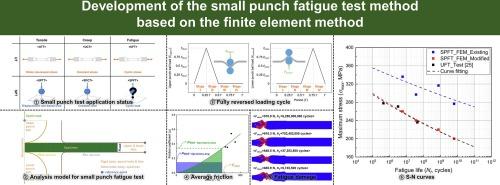基于有限元法的小冲孔疲劳试验方法的开发
IF 5.7
2区 材料科学
Q1 ENGINEERING, MECHANICAL
引用次数: 0
摘要
小冲压试验(SPT)是一种评估金属材料机械性能的方法,它克服了传统测试方法单轴试验(UT)的局限性。UT 为每个应力提供应变数据,而 SPT 则为每个载荷提供位移数据。因此,必须将 SPT 转换为 UT,才能评估材料的机械性能。然而,SPT 和 UT 采用不同的加载机制。将 SPT 转换为 UT 的困难源于不同的加载机制,因此迄今为止,SPT 只局限于拉伸和蠕变等机械性能评估领域。因此,本文旨在将目前仅限于拉伸和蠕变领域的 SPT 扩展到疲劳领域。基于有限元法(FEM)的小冲压疲劳试验(SPFT)对金属材料的疲劳特性进行了评估。此外,还利用等效方程将有限元法得出的 SPFT 疲劳特性转换为单轴疲劳试验(UFT)。最后,根据 SPFT 构建了 S-N 曲线,并与根据 UFT 构建的相同曲线进行了比较验证。本文章由计算机程序翻译,如有差异,请以英文原文为准。

Development of the small punch fatigue test method based on the finite element method
The Small Punch Test (SPT) is a method of evaluating the mechanical properties of metallic materials that overcomes the limitations of the Uniaxial Test (UT), a traditional method of testing. Unlike UT, which provides strain data for each stress, SPT provides displacement data for each load. Therefore, SPT must be converted to UT to evaluate the mechanical properties of materials. However, SPT and UT employ disparate loading mechanisms. The difficulty in converting SPT to UT, which stems from the disparate loading mechanisms, has thus far limited SPT to mechanical property evaluation areas such as tensile and creep. This paper, therefore, aims to extend SPT to the fatigue domain, which is currently limited to the tensile and creep domains. The fatigue properties of metallic materials were evaluated based on the Finite Element Method (FEM) for the Small Punch Fatigue Test (SPFT). Moreover, the fatigue properties derived from the FEM for SPFT were converted to Uniaxial Fatigue Test (UFT) by employing the equivalent equation. Finally, an S-N curve was constructed based on SPFT and was validated by comparison with the same curve constructed based on UFT.
求助全文
通过发布文献求助,成功后即可免费获取论文全文。
去求助
来源期刊

International Journal of Fatigue
工程技术-材料科学:综合
CiteScore
10.70
自引率
21.70%
发文量
619
审稿时长
58 days
期刊介绍:
Typical subjects discussed in International Journal of Fatigue address:
Novel fatigue testing and characterization methods (new kinds of fatigue tests, critical evaluation of existing methods, in situ measurement of fatigue degradation, non-contact field measurements)
Multiaxial fatigue and complex loading effects of materials and structures, exploring state-of-the-art concepts in degradation under cyclic loading
Fatigue in the very high cycle regime, including failure mode transitions from surface to subsurface, effects of surface treatment, processing, and loading conditions
Modeling (including degradation processes and related driving forces, multiscale/multi-resolution methods, computational hierarchical and concurrent methods for coupled component and material responses, novel methods for notch root analysis, fracture mechanics, damage mechanics, crack growth kinetics, life prediction and durability, and prediction of stochastic fatigue behavior reflecting microstructure and service conditions)
Models for early stages of fatigue crack formation and growth that explicitly consider microstructure and relevant materials science aspects
Understanding the influence or manufacturing and processing route on fatigue degradation, and embedding this understanding in more predictive schemes for mitigation and design against fatigue
Prognosis and damage state awareness (including sensors, monitoring, methodology, interactive control, accelerated methods, data interpretation)
Applications of technologies associated with fatigue and their implications for structural integrity and reliability. This includes issues related to design, operation and maintenance, i.e., life cycle engineering
Smart materials and structures that can sense and mitigate fatigue degradation
Fatigue of devices and structures at small scales, including effects of process route and surfaces/interfaces.
 求助内容:
求助内容: 应助结果提醒方式:
应助结果提醒方式:


